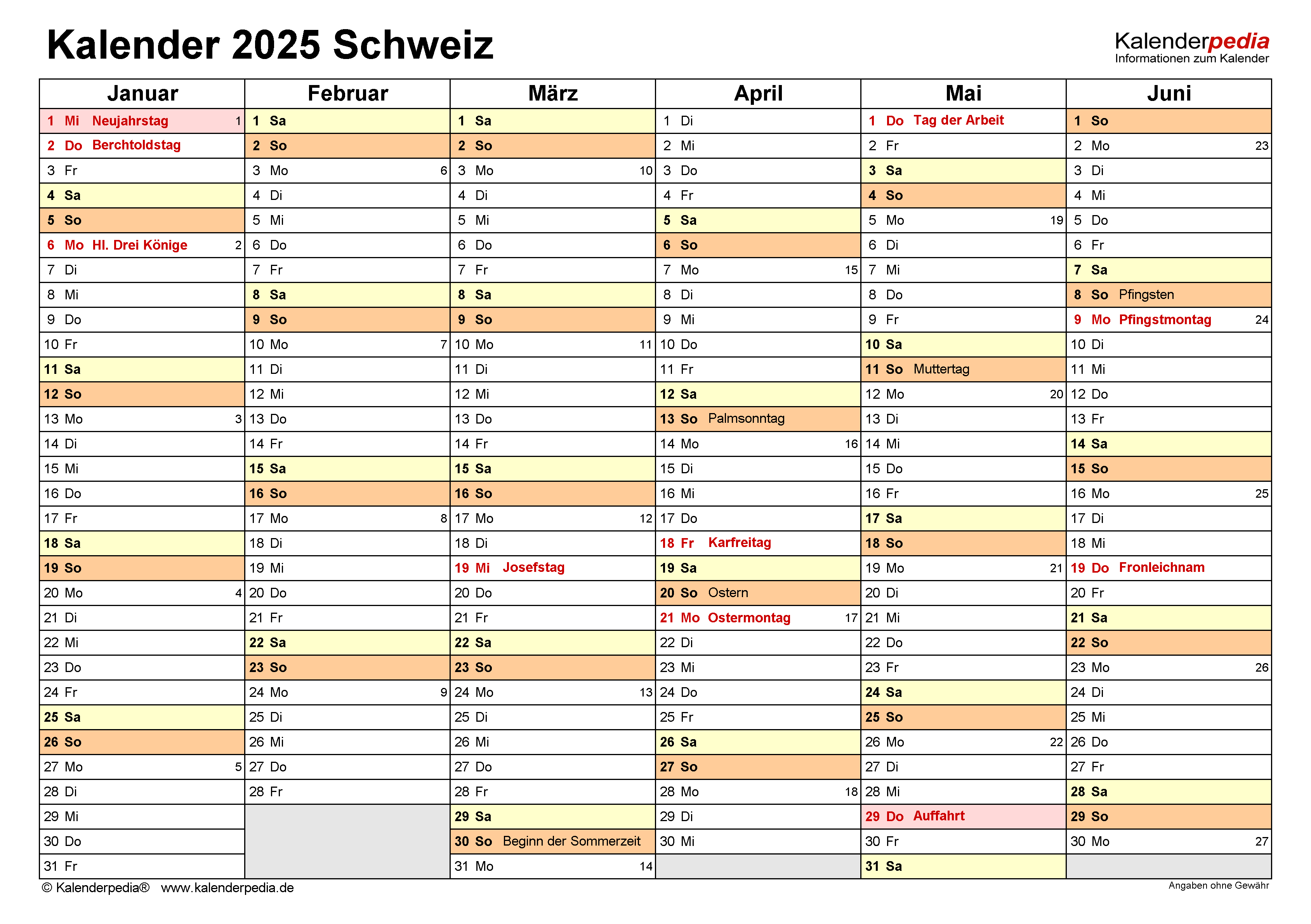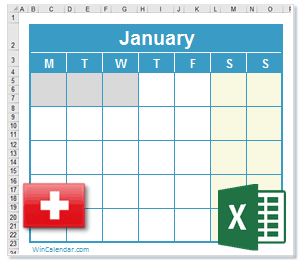2025 Swiss Calendar: 2-Page Excel Tips

As we embark on the year 2025, it's time to gear up with efficient tools and strategies to navigate through the year productively. One indispensable companion for many professionals and individuals is the calendar. In this comprehensive guide, we will explore the 2025 Swiss Calendar, offering a 2-page layout and practical Excel tips to help you make the most of your time and stay organized throughout the year.
The Swiss Calendar: A Timeless Companion

The Swiss Calendar has long been a trusted tool for its simplicity, functionality, and accuracy. With a focus on practicality, the Swiss Calendar provides a clear and concise overview of the year, making it an ideal choice for those seeking efficiency and order.
Key Features of the 2025 Swiss Calendar
- Two-page monthly spread: Each month is presented across two pages, offering ample space for note-taking and planning.
- Swiss precision: The calendar adheres to the Swiss reputation for precision, ensuring accurate dates and holidays.
- Clean design: The minimalist layout ensures a distraction-free planning experience, allowing you to focus on your goals and tasks.
- Holidays and observances: National and regional holidays are marked, providing a quick reference for important dates.
Now, let's delve into some Excel tips to enhance your calendar experience and take your time management skills to the next level.
Excel Tips for Efficient Calendar Management

Microsoft Excel, a powerful spreadsheet software, can be a game-changer when it comes to calendar management. Here are some expert tips to unlock the full potential of your 2025 Swiss Calendar using Excel.
Create a Digital Version of Your Calendar
One of the first steps to efficient calendar management is to digitize your 2025 Swiss Calendar. By creating a digital version, you gain the flexibility to make changes, add notes, and organize your schedule seamlessly.
- Import the Calendar: Begin by importing the Swiss Calendar data into Excel. You can find downloadable calendar templates online or create your own using the basic structure.
- Format the Cells: Adjust the cell formatting to match the calendar's layout. Set the date format and ensure that each cell represents a day.
- Add Holidays and Events: Import or manually input important dates, holidays, and events specific to your region or personal schedule.
Once your digital calendar is set up, you can easily navigate and make changes as needed. This digital version becomes a dynamic tool, allowing you to stay organized and adapt to any schedule changes throughout the year.
Utilize Excel's Conditional Formatting
Excel's conditional formatting feature is a powerful tool to visually highlight important dates and events on your calendar. By applying specific formatting rules, you can quickly identify key dates and tasks at a glance.
- Highlight Important Dates: Create a rule to highlight cells based on specific criteria, such as marking all weekend days or highlighting dates with upcoming events.
- Color-Code Categories: Assign colors to different categories of events, such as work meetings, personal appointments, or holidays. This color-coding system makes it easy to identify the nature of each event.
- Visualize Task Priorities: Use conditional formatting to indicate task priorities. For instance, high-priority tasks can be formatted with a bold font or a specific background color.
Conditional formatting not only enhances the visual appeal of your calendar but also serves as a practical reminder of your schedule and priorities.
Integrate Reminders and Notifications
Excel offers various ways to integrate reminders and notifications into your calendar, ensuring you stay on top of your schedule and never miss an important event.
- Data Validation: Use data validation to restrict entries in specific cells. For example, you can set a rule that allows only a certain date range for event entries, preventing errors and ensuring consistency.
- Formula-Based Reminders: Employ formulas to calculate the time remaining until an event. This dynamic reminder system keeps you aware of upcoming deadlines and important dates.
- Visual Reminders: Create a visual reminder system by adding icons or symbols to cells representing specific events. This simple visual cue can be a powerful reminder, especially for visual learners.
By integrating these reminder systems into your Excel calendar, you can ensure a more proactive approach to time management and stay organized throughout the year.
Automate Task Management with Macros
Excel's macro feature allows you to automate repetitive tasks, saving time and effort. By creating custom macros, you can streamline your calendar management and focus on more important tasks.
- Automate Data Entry: Create macros to automate data entry for recurring events or tasks. This can be especially useful for weekly or monthly recurring appointments.
- Quick Formatting: Develop macros to apply specific formatting styles to cells based on certain conditions. For instance, you can create a macro to format cells as "overdue" if the task date has passed.
- Send Reminder Emails: With advanced macro programming, you can even set up Excel to send automated reminder emails for important events, ensuring you stay connected with your schedule.
Macros provide a powerful way to streamline your calendar management, making it more efficient and reducing the risk of errors.
Advanced Calendar Tips for Power Users
For those seeking to take their calendar management to the next level, here are some advanced tips to explore:
Create a Master Task List
A master task list can be a powerful tool for managing your schedule and ensuring nothing slips through the cracks. Here's how you can create one:
- Dedicated Task Sheet: Create a separate sheet within your Excel workbook dedicated solely to your task list.
- Dynamic Task List: Use formulas to populate the task list based on specific criteria, such as tasks due within the next week or tasks assigned to specific projects.
- Sort and Filter Tasks: Utilize Excel's sorting and filtering features to organize your tasks by priority, due date, or project, ensuring a clear overview of your workload.
A master task list keeps you organized and allows for efficient time management, especially when dealing with complex schedules.
Integrate with Other Tools
Excel's versatility allows for seamless integration with other productivity tools and software. Here are some ideas for integration:
- Sync with Online Calendars: Synchronize your Excel calendar with online calendar platforms like Google Calendar or Outlook, ensuring your schedule is accessible across devices.
- Connect with Project Management Tools: If you use project management software, consider integrating your calendar with it. This allows for a holistic view of your projects and tasks.
- Collaborate with Team Members: Share your Excel calendar with team members, allowing for a centralized view of schedules and ensuring efficient collaboration.
By integrating your Excel calendar with other tools, you create a powerful ecosystem for managing your time and projects.
Track Progress and Analyze Performance
Excel's data analysis capabilities can be utilized to track your progress and analyze your calendar performance over time. Here's how:
- Track Task Completion: Create a simple tracking system within Excel to monitor the completion of tasks. This can be done by adding a "completed" column or using conditional formatting to highlight completed tasks.
- Analyze Productivity: Use Excel's pivot tables to analyze your task completion rates, identify trends, and optimize your time management strategies.
- Visualize Data: Create charts and graphs to visualize your calendar data. This visual representation can provide valuable insights into your schedule and help identify areas for improvement.
By tracking and analyzing your calendar performance, you can make informed decisions to enhance your productivity and time management skills.
Conclusion: A Year of Efficient Organization
With the 2025 Swiss Calendar and these Excel tips, you are equipped to tackle the year with efficiency and organization. By digitizing your calendar, utilizing Excel's powerful features, and implementing advanced strategies, you can make the most of your time and achieve your goals.
Whether you're a busy professional, a student, or simply someone seeking better time management, this guide provides a comprehensive toolkit to stay on top of your schedule and navigate the year with confidence.
Frequently Asked Questions

Can I customize the Swiss Calendar’s layout in Excel?
+
Absolutely! Excel offers a range of formatting options to customize the calendar’s appearance. You can adjust fonts, colors, and cell sizes to match your preferences.
Are there any online resources for Swiss Calendar Excel templates?
+
Yes, there are numerous websites and platforms that offer free and premium Swiss Calendar Excel templates. A simple online search can lead you to a variety of options to choose from.
Can I share my Excel calendar with others?
+
Certainly! Excel allows you to share your calendar with colleagues or family members. You can use Excel’s sharing options or export the calendar as a PDF or image file for easy sharing.
Is it possible to sync my Excel calendar with my smartphone calendar app?
+
Yes, Excel calendars can be synced with smartphone calendar apps. You can use cloud-based storage services or calendar sync tools to ensure your calendar is accessible across devices.
Can I create a yearly overview in Excel for the 2025 Swiss Calendar?
+
Absolutely! Excel allows you to create a yearly overview by consolidating monthly data. You can use pivot tables or formulas to summarize and present a comprehensive yearly view of your calendar.



